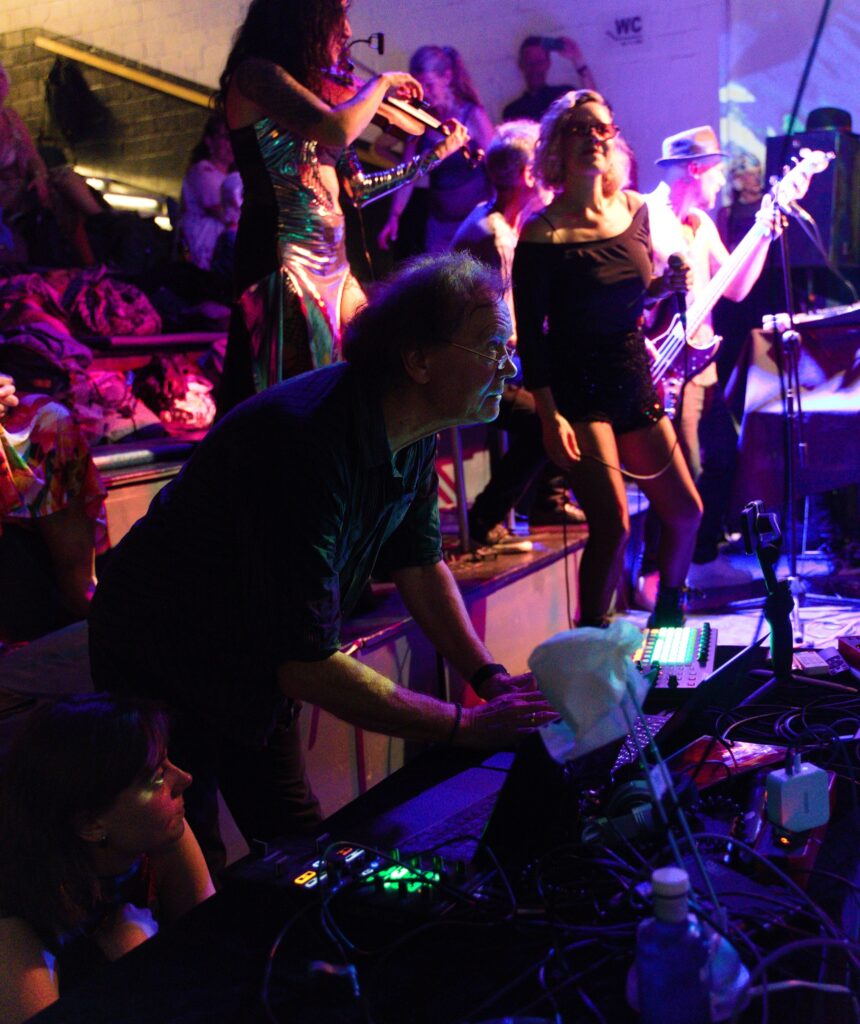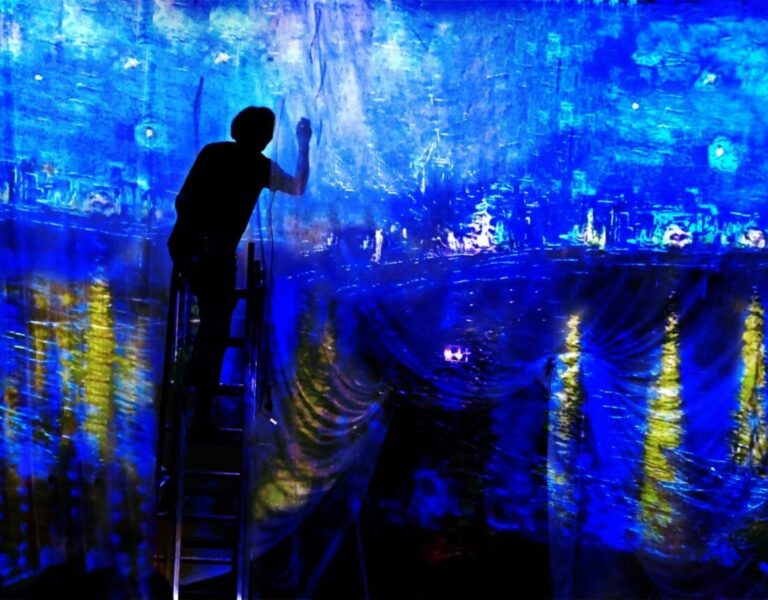Link to original article at tango21.info
By Geert Boettger –
13/07/2025
Visual Poetry
The visual poetry immediately catches the eye: the dance space is flooded with projections—changing color worlds, rows of houses, landscapes, abstract patterns, symbols, the real and the surreal.
Five VJanes and VJs with different approaches were invited to design the space with their visuals as a living, constantly changing environment. The room as a visual reference point thus takes on a life of its own. It captivates our minds and senses with its powerful images… in addition to the music and the people moving around the room. You can immerse yourself in the worlds of images, colors, and patterns and see how people dance in them, disappear, and then reappear more indistinctly on the opposite side, while the first dance floor is danced on again by other couples.
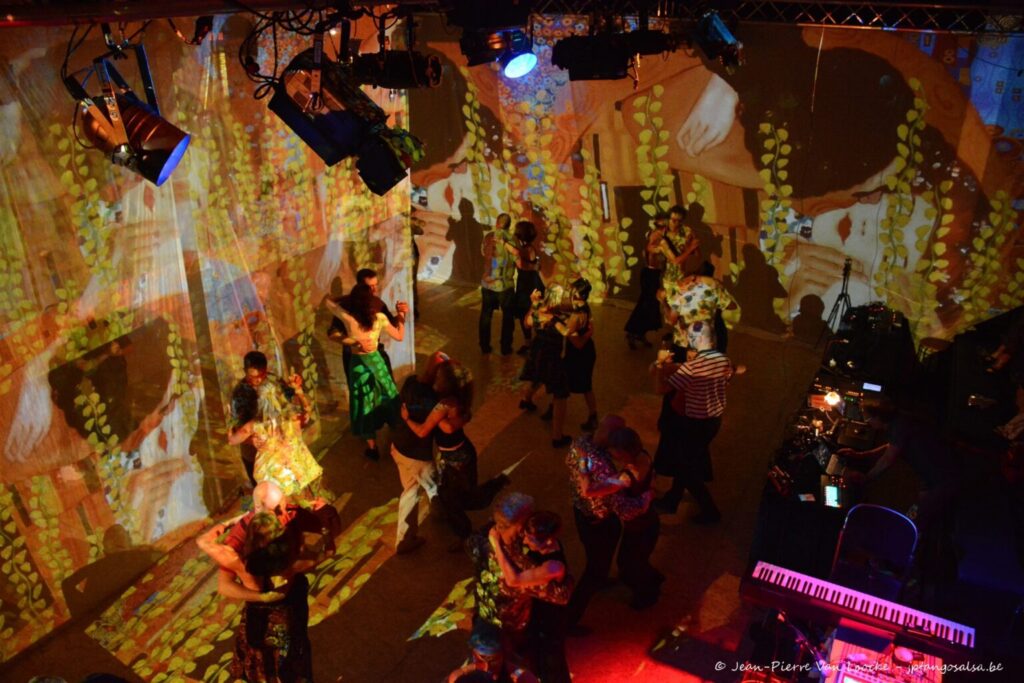
Its sensual effect is sometimes reminiscent of the psychedelic aesthetics of the 1960s and 70s – only without lysergic acid diethylamide, etc. You are looking at a dance scene in other worlds, and yet it is also your world and that of your dance community, and you are part of this scene. This visual transcendence opens up new perspectives that you first want to let sink in, or have to let sink in.
But that is only the first obvious thing. The neoTangoRave is a magical artistic and social event, like a great, positive utopia.
Complete artistic experience at Schaulust
From June 13 to 15, 2025, the cultural space of Schaulust e.V., a self-managed cultural and creative center on the site of the former freight yard in Bremen, was once again transformed into an audiovisual Gesamtkunstwerk.
For three days, sound, movement, and light merged into a comprehensive sensory experience. A dance and music weekend like a mental stimulant—full of encounters, comprehensive new impressions, and aesthetic intensity. It is a unique, fascinating world in the cosmos of tango events.
Tanguerilla Visual Poetry – the mastermind behind the rave
The initiator and organizer of neoTangoRave (nTR) is the Bremen-based artist Tanguerilla Visual Poetry. His self-image:
“neoTangoRave is and always has been an avant-garde, anti-elitist, and visionary tango event, as well as a platform for innovative artists.”
He also conceived nTR as a low-budget event. On the one hand, this means that cost-cutting teamwork is required to organize and run the event. On the other hand, it creates a sense of community because many of the visitors are not just visitors, but also participants.
For example, there is a setup and teardown team for the complex installation of the technology and the textile room lining for the projections. The DJs and video artists also waive their usual fees, creating a great sense of togetherness.
A large proportion of the ravers actively contributed to the success of the event. Going there and consuming becomes largely about participating and contributing.
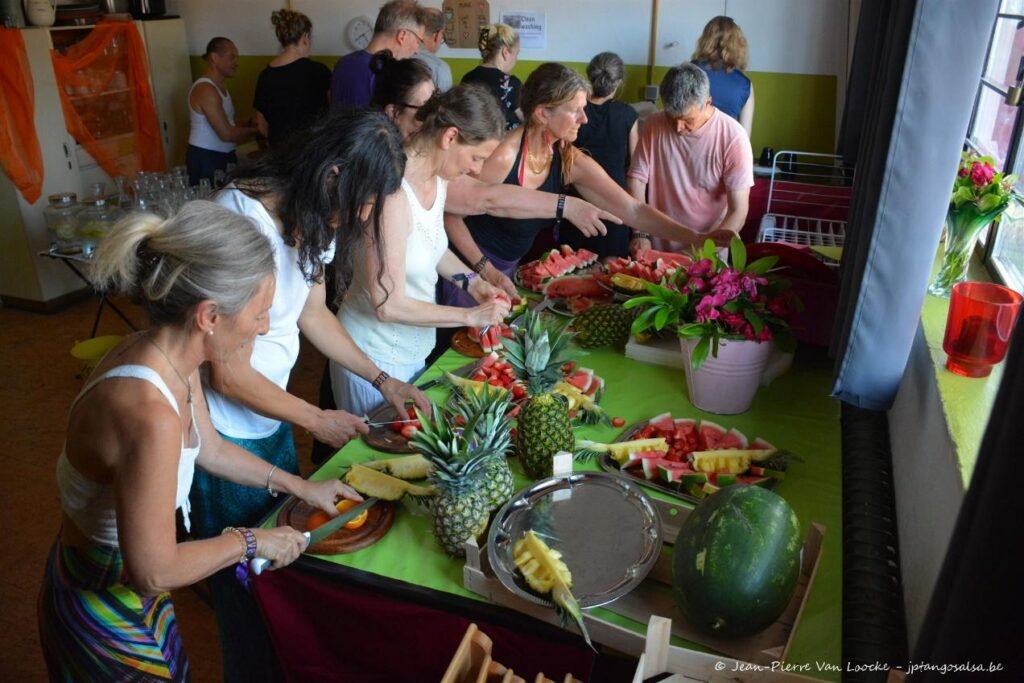
Peparing fruity refreshments together (Photo: Jean-Pierre n Loocke)
New developments in tango music
10 DJs from five countries were invited to present their view of neotango and its facets beyond traditional tango music.
The result was a musical kaleidoscope ranging from newly arranged tango classics to electro tango with accompanying music computers to tango-inspired pieces with elements of jazz, rock, blues, and folk styles.
Non-tango pieces with interesting dynamics and inviting musical verve were also part of the repertoire. This is reminiscent of contemporary experiments by tango musicians in Buenos Aires, such as OT Di Pasquale or the “Populares” cycle by Siempre Tango.
Tango has always been fusion – nTR demonstrates this in an impressively wide variety.
Each DJ had their own style and individual focus, offering dancers a wide variety of music.
The neoTangoRave deliberately goes beyond the traditional milonga and opens up a broad spectrum of new lines of development in tango. Sometimes the music selection is simply determined by the maxim: the main thing is that it’s good to dance to.
Tanguerilla Visual Poetry has asked the DJs in 2025 to take the proximity to tango more into account than is now customary in many neolongas.

Tangorra featuring Eliana Sosa at neoTangoRave 2025 (Photo: Jean-Pierre van Loocke)
New impulses for the danced tango
All DJs and DJanes were well and very well received by the dancers with their presentations. This openness is remarkable: where traditional tango often rejects new soundscapes as “undanceable,” neo-dancers embrace them—curious, playful, and often expressive.
This is accompanied by a more open basic dance posture, which gives more scope for movement within the couple. This gives the dance partners much more opportunity to express themselves, including independent turns such as those used in salsa or rock ‘n’ roll.
The fascination of the close embrace, e.g., in Tango Milonguero, is broken here. As stimulating as the movement in the close embrace may be, communication with more distance can be just as interesting.
Many dance couples in nTR use elements of traditional tango styles (salon, milonguero) as well as more open postures and figures associated with other dances, including contact improvisation.
This opening up of dance styles is a fundamental element of neotango. This is particularly evident at nTR because each dance couple becomes a work of art in front of the visuals – e.g., Art Nouveau ornamentation à la Klimt. Watching this is an artistic happening in the truest sense of the word.
In the afternoon, there were also a series of dance workshops, e.g., on the topic of “gentle leading.”
The staircase grandstand – an auditorium of wonder
The dance floor resembles a stage in front of a wide staircase grandstand constructed from wooden planks. Here, spectators experience the entire scene as a constantly changing Gesamtkunstwerk – sometimes dynamic, sometimes meditative – depending on the interplay of visuals with the music and the dancers.
Many dancers take a break here, some lie down on the boards and let the scenery sink in. The architecture enhances the effect: the projections unfold in the depth and height of the room, refracting off the movement of the bodies and blurring the boundaries between real and projected.
Thanks to good sound technology, the rhythms and melodies are omnipresent in the ears and bodies.

Staircase (Photo: JP. Van Loocke)
The outdoor terrace as a resonance room
The sun-drenched outdoor terrace is the second heart of the nTR. Here, visitors can breathe deeply, talk, look around, and feel. It is a place of retreat, a meeting place, a resonance chamber—a contrast to the visual and acoustic density of the interior.
Here, a different pace emerges, a different kind of togetherness. It is also this alternation between intense and relaxed togetherness that makes the nTR so impressive..
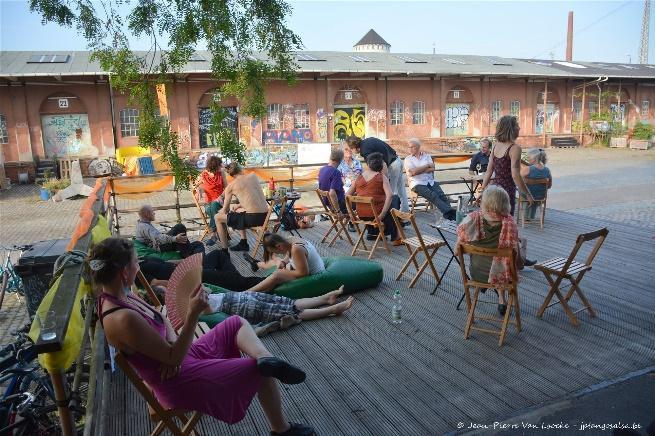
Outdoor terrace at neoTangoRave 2025 (Photo: Jean-Pierre van Loocke)
neoTangoRave in Bremen: A beacon of modern tango events (Part 2)
Link to original article at tango21.info
By Geert Boettger –
13/07/2025
Live highlights 2025
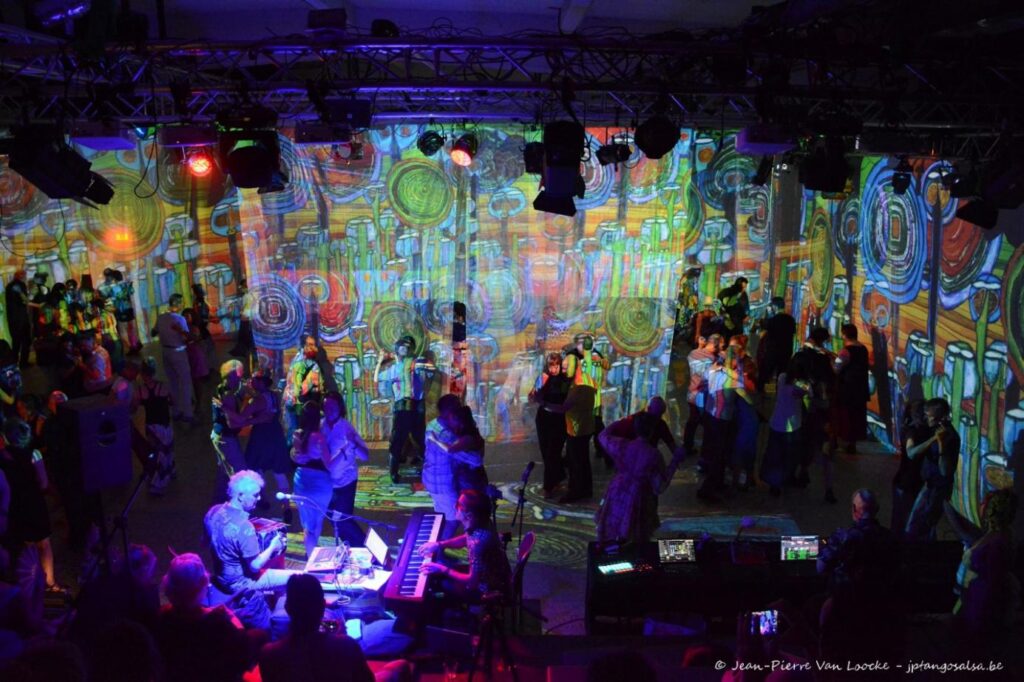
Narcotango at neoTangoRave 2025 (Photo: Jean-Pierre van Loocke)
The neoTangoRave 2025 had a special highlight every evening. On Friday, Narcotango, one of the iconic groups of modern tango, performed. On Saturday, Tangorra Orquesta Atipica, one of the defining bands of electrotango for 15 years, took the stage, and on Sunday, Narcotango offered a live jam in dialogue with Berlin DJ Mona Isabell. The high quality of the groups is underscored by the fact that both Narcotango and Tangorra, who performed with the expressive singer Eliana Sosa, were nominated for the Premios Tango Siglo XXI 2025. Narcotango won this award for their 2024 album Anarcolonga in the electrotango category.
All three live acts succeeded in moving the ravers with their music and energy and linking neoTangoRave2025 with memorable experiences that many participants will surely look back on for years to come.
The performance by Narcotango had a very personal touch, showing in two ways how strongly the event is anchored in the community and is also being anchored by Tanguerilla. At the beginning of the concert, Tanguerilla commemorated the late Berry Thompson and Raymond Lauzzana, who had played a decisive role in past raves and were very constructive members of the nTR community, with very personal words and musical accompaniment by Narcotango
At the end of Narcotango’s performance, the rave turned into a birthday party for a while, because Carlos Libedinsky had played into his birthday.
So much for the artistic dimension of the neoTango Rave. Less spectacular but of profound importance for the overall mood and togetherness in the community is the social dimension. We have already reported that it is a low-budget event that relies heavily on teamwork and turns numerous visitors into active co-creators of the event. However, there are more values and behaviors that make nTR an event that further develops tango and also leads it out of the social museum that is often still maintained.

Tangorra feat. Eliana Sosa at Bremen 2025 (Photo: Jean-Pierre van Loocke)
Freedom from roles and equality
Traditionally, tango is a macho dance: men lead and women follow. Although there are nuances in classical tango, the roles are clearly defined. nTR breaks this pattern: women lead, men dance with each other, and the role reversal of leaders and followers during a song is particularly exciting. Heterosexuals, female and male couples, everyone is welcome.
This makes the social atmosphere more relaxed and open—a cooperation between equals. At nTR, this is encouraged, among other things, by the fact that Friday is “Ladies Day.” Asking women to dance is part of the program on Fridays, but the process of asking seems to have become much more balanced even without this rule.
The role of women has also been strengthened in other ways, such as through the selection of DJs and VJs. Five women and five men were involved in the music selection, and three women and two men in the visual design.
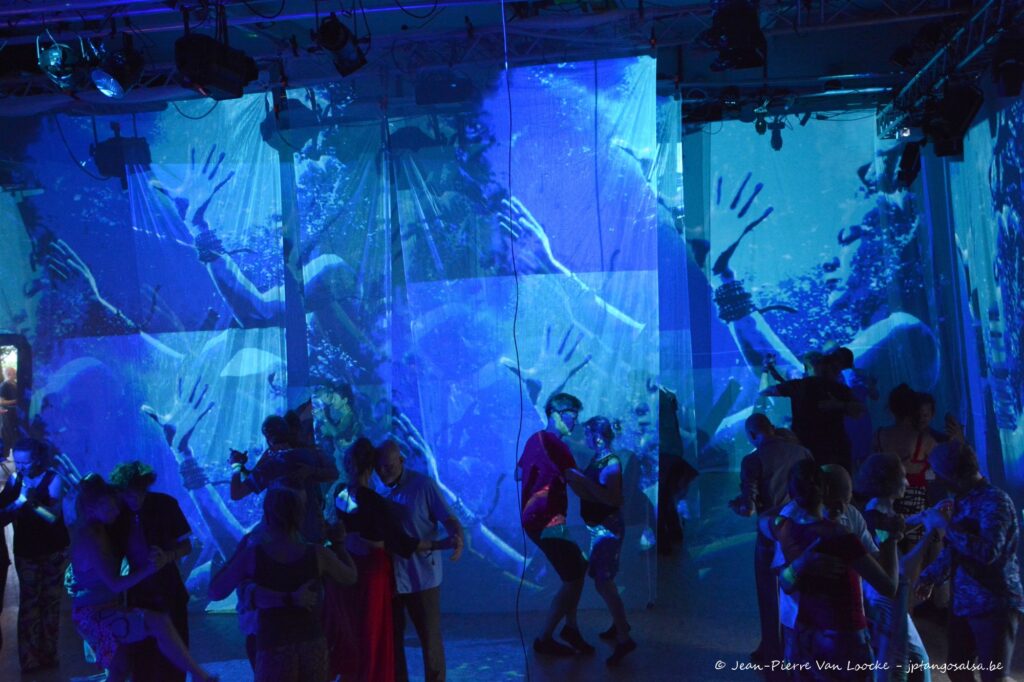
Impression of dance floor at neoTangoRave 2025 (Photo: Jean-Pierre van Loocke)
From the canon of rules to freedom
From the late 1980s onwards, tango was taught in Europe not only as a dance, but also as a set of rules. Discreet invitations via cabeceo and mirada, separation of dances into tandas, silence during the dance – all of this was taught as “authentic Argentine codigos.” Those who did not adhere to them were considered outsiders. However, these rules often create social distance: dance couples find each other almost anonymously, the 20 to 30 seconds of chamuyo customary in Argentina at the beginning of the music are considered disruptive, and after one, two, or at most three tandas, it’s over.
This often makes it difficult for unknown guests or infrequent milonga visitors to enter the community and experience tango as a social dance in a positive way. Instead, small and large circles and “elites” form in a milonga, who have gotten to know each other over a long period of time and remain among themselves.
At nTR, all of this is deliberately left aside. It’s about communication, spontaneity, liveliness. There are no cortinas; the dancers decide for themselves when they want to stop or change partners. Everything is done with consideration for the other dancing couples. The DJs are also freer – in their dramaturgy, their selection, their courage to surprise.
Clothing and physicality: between representation and comfort
Tango is sensual – and sensuality always goes hand in hand with aesthetic standards. Clothing, fragrance, charisma – all of these things play a role. At traditional milongas, women almost always wear high heels and are carefully styled. Men rarely wear colors or unconventional clothing. This is also different at nTR. Only about a quarter of the women here dance in high heels – comfort, health, and freedom of movement are the priority. The clothing is more colorful, more relaxed, more individual. It’s not about dress codes, but about expression. This relaxed atmosphere carries over into the dancing: sensual, yes – but without the pressure to look a certain way..
Conclusion: neoTangoRave as cultural innovation in action
neoTangoRave is more than just a festival. It is a cultural intervention in the tango cosmos and a lively plea for openness, diversity, and artistic freedom. The music is more contemporary, the space is decorated with modern visual art, and the social interaction is freer, more open, and less role-bound than at many other milongas, encuentros, and festivals—and that’s precisely why everything feels so forward-looking. Not everything is new and unique in Bremen, but the overall package is a beacon visible from afar in the landscape of modern tango events.
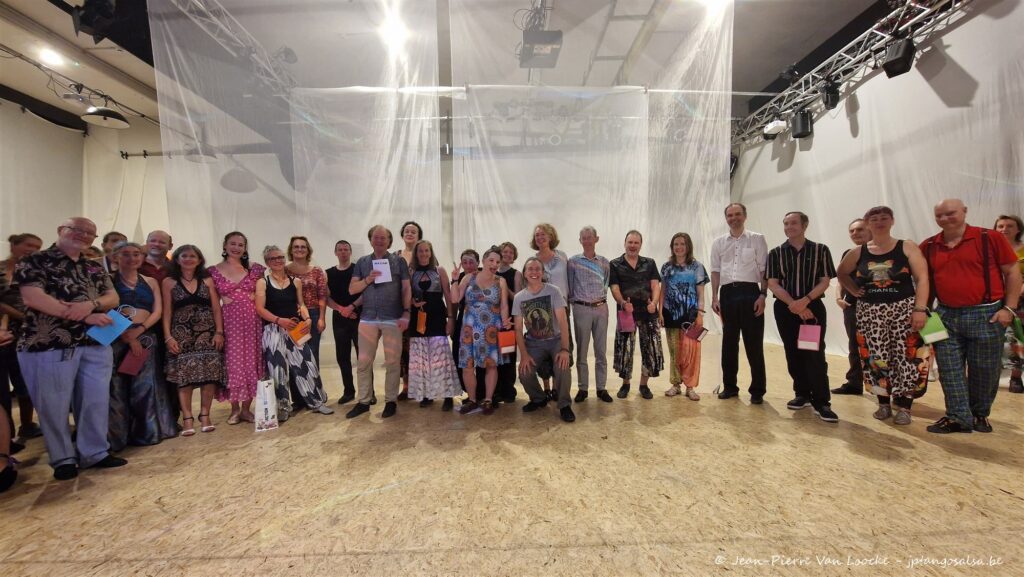
Majority of the teams nTR 2025 (Photo: Jean-Pierre van Loocke)
P.S. Special thanks go to the enthusiastic photographer Jean-Pierre van der Loocke. He has documented neoTangoRave in a very appealing and accurate way. We are grateful that we are allowed to use some of his photos. Many more can be found on his Facebook page (https://www.facebook.com/jeanpierre.vanloocke).
There is a lot of modern tango music for dancing.
Link to original article at tango21.info
By Geert Boettger –
13/07/2025

Tanguerilla at work (Photo: Tanguerilla)
Interview with Tanguerilla about the neoTangoRave in Bremen
Tango21: When and why did you start neoTangoRave?
Tanguerilla: Since 2004, I have organized many one-day tango events in Germany and abroad as Tanguerilla, in Warsaw, Brody, Nijmegen, Vienna, Riga, London, Stockholm, Halmstadt, Rome, Mar del Plata, Buenos Aires, Nantes, Turin, Sacramento, Los Angeles, Toulouse, and Basel. In 2011, I decided to extend the immersive concept to an entire weekend in response to numerous requests from the neoTango community. At the time, it was the first neoTango festival in Europe and served as a model for several similar events, most of which I subsequently helped to initiate and support.
I started doing this because there were new impulses in tango music, a new sound, tangos with modern beats and contemporary rhythms. For me, it all started with Melingo and his album Tango Bajos in 1998. From around 2003 onwards, there were more and more groups such as Gotan Project, Bajofondo, etc., who created their own musical movement within tango and represented a real alternative to classical tango. However, this music was not played in the classical milongas.
The mainstream dismissed it as techno tango or undanceable “tango under” and gave this modern tango music no space. I wanted to make a contribution here and worked with the new groups and musicians in various ways to improve their performance opportunities and promote this music.
Gotan Project already worked with visuals, and as a trained media designer, I made this a central element of my events because it enabled an artistically innovative and powerful connection to music and dance.
Tango21: Has the concept changed over time?
Tanguerilla: It has always been important to me to give my events an innovative profile; I’m not interested in the mainstream at all. The core audio-visual concept has not changed significantly. NeoTangoRave is and always has been an avant-garde, anti-elitist, and visionary tango event and a platform for innovative artists.
It is a solidarity event and is conceptually based on Osvaldo Pugliese’s cooperative orchestra model, which is based on (gender) equality, care, innovation, personal development, improvisation, fun, and the right to make mistakes.
Mandatory rondas and cabeceos, tandas & cortinas have no meaning in this concept.
Over time, the festival’s size and appeal have steadily grown, so that it is now sold out within minutes every year.
his year, for the first time, I asked the DJs to include at least 50% contemporary tango in their musical concept. This is in response to a development in neotango that I would like to counteract.
After the decline of the neotango scene in the 2010s, the so-called neolongas have increasingly turned to non-tango music, world music, pop, interesting rock, jazz, and ambient tracks, etc.
Modern tango is insufficiently considered by the neolongas today, even though modern tango was the starting point for alternative milongas or neolongas. I find this very unfortunate, because the creative basis of modern tango music has broadened, so that since around 2000, tango has provided a wealth of musical material for modern-oriented tango dancers.
This is apparently forgotten or insufficiently known by many neotango DJs. Contemporary tango finds itself in a very thankless position here, because the classic milongas reject it and the non-tango-dominated neolongas have “forgotten” it.
I want to continue promoting modern tango music, as I have done from the beginning, and have therefore asked my guest DJs to play more modern tangos. There is so much rich material available that neotango dancers can also move to contemporary tango music.
Tango21: What touches you most at tango events?
Tanguerilla: What touches me most in general is when personality becomes visible and powerful.
This happens when DJanes dare to play unwieldy, individual, novel tangos and weave them into a danceable musical tapestry.
This happens when VJanes conjure up fantasies on the staggered screens, captivating dancers and spectators alike and transporting them into worlds of color.
This is what happens when tango bands make the air vibrate and their music challenges the dancers‘ ability to improvise.
But above all, this is what happens when I meet a dancer who overcomes gravity with me in endless spirals.
